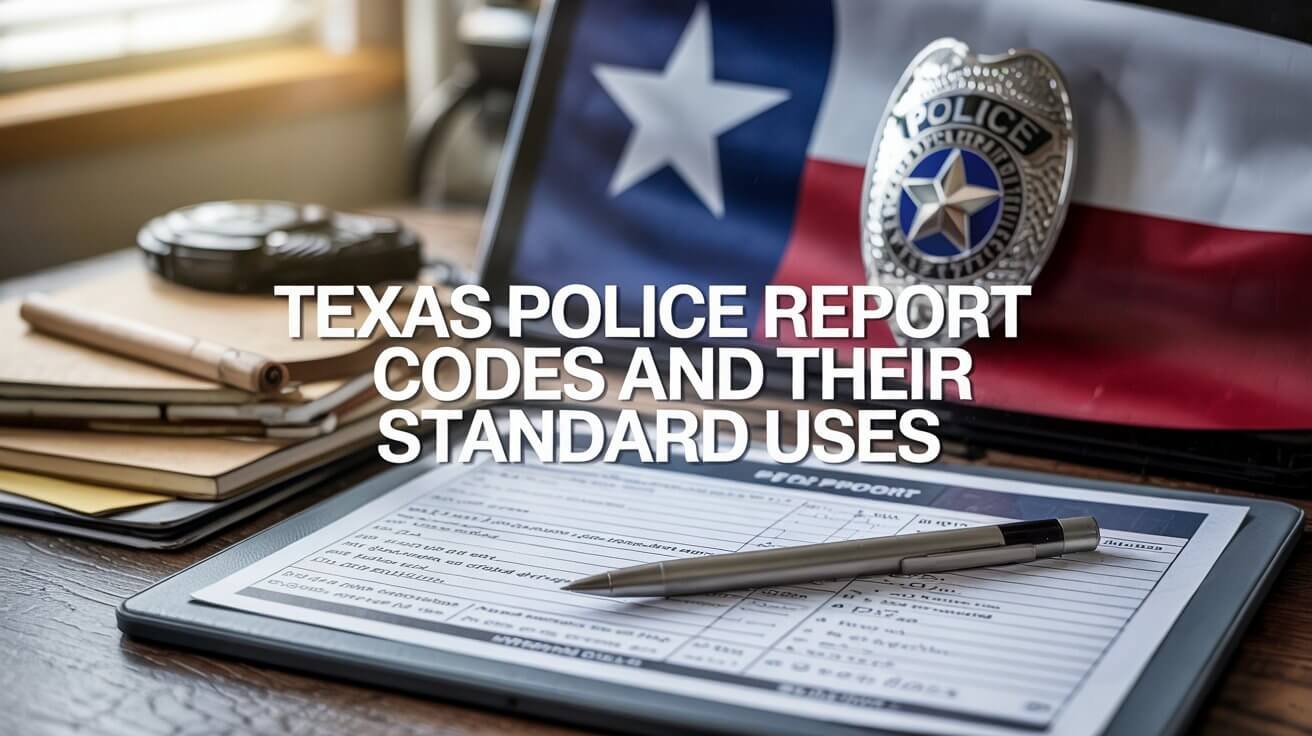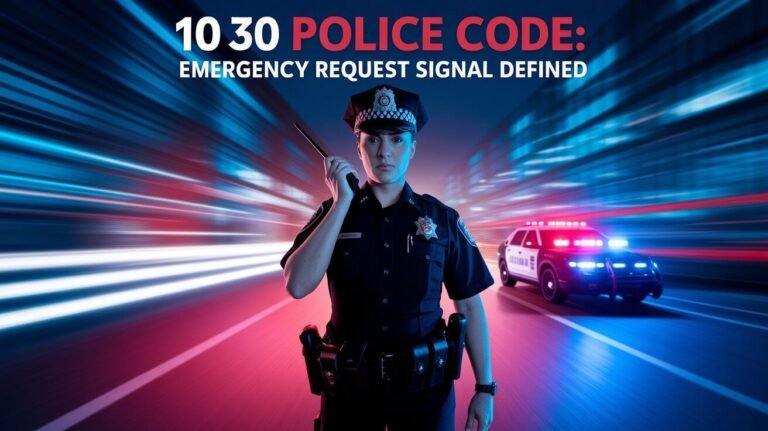Texas Police Report Codes and Their Standard Uses

Law enforcement agencies in Texas rely on standardized codes to document and analyze data from various incidents. The Texas Peace Officer’s Crash Report forms are a crucial tool in this process, providing a structured format for officers to record details of crashes.
These forms utilize a specific set of codes to categorize and summarize the information collected during investigations. By using these codes, law enforcement can efficiently process and analyze the data, helping to identify trends and patterns.
Key Takeaways
- The Texas Peace Officer’s Crash Report forms are essential for documenting crash data.
- Standardized codes facilitate efficient data processing and analysis.
- Law enforcement agencies use these codes to identify trends and patterns.
- The codes play a critical role in maintaining accurate records.
- Effective use of these codes enhances the overall quality of crash reports.
What Are Police Report Codes in Texas?
Understanding police report codes is crucial for navigating the complexities of law enforcement documentation in Texas. Police report codes are essential for categorizing and analyzing data related to incidents and crashes across the state.
Official Definition and Function
Police report codes are standardized numerical values used to classify various aspects of an incident or crash, such as person type, injury severity, and vehicle information. The official definition of these codes is rooted in their ability to provide a uniform language for law enforcement officers to document incidents. The primary function of these codes is to facilitate the accurate and efficient recording of details, which can then be used for statistical analysis, insurance purposes, and law enforcement reporting.
The Texas Peace Officer’s Crash Report form is a prime example of how these codes are utilized, with sections dedicated to coding person type (e.g., driver, passenger, pedalcyclist) and injury severity (e.g., incapacitating injury, non-incapacitating injury).
Texas-Specific Code System
The Texas-Specific Code System is designed to meet the unique needs of law enforcement in Texas. This system includes a range of codes that are specific to the state’s requirements, such as those related to traffic accidents and other incidents. For instance, the code sheet lists various codes for vehicle information, including vehicle type and damage extent.
Using a standardized code system, Texas law enforcement agencies can ensure consistency in reporting, making it easier to analyze data and identify trends. This, in turn, can inform policy decisions and improve road safety initiatives.
History and Development of Police Codes in Texas
The development of police codes in Texas is a story of evolution and adaptation. Over the years, the Texas law enforcement agencies have refined their coding systems to better serve the needs of the public and the officers on the ground.
Origins and Early Implementation
The origins of police codes in Texas date back to the early days of law enforcement in the state. Initially, codes were simple and primarily used for basic communication. As the complexity of law enforcement tasks grew, so did the need for a more sophisticated coding system. The early implementation of these codes laid the groundwork for the advanced systems used today.
Digital Transformation of Code Systems
A significant milestone in the evolution of Texas police codes was the introduction of the CRASH (Crash Reporting and Analysis System) system. This digital platform enabled law enforcement agencies to electronically submit crash reports, significantly streamlining the process and improving data accuracy. The CRASH system represents a crucial step in the digital transformation of code systems, enhancing the efficiency of law enforcement operations.
Recent Updates and Changes
In recent years, Texas law enforcement has continued to update and refine its code systems. Updates to forms and code sheets have been implemented to reflect changing circumstances and to improve the clarity of the codes. These changes are crucial for maintaining an effective and efficient law enforcement system, particularly in areas such as Texas Crash Reports. The ongoing evolution ensures that the system remains relevant and useful for Law Enforcement agencies across the state.
Texas Police Report Codes: Complete Classification System
The Texas Police Report Codes classification system is a complex framework used by law enforcement agencies across the state. This system is designed to standardize the reporting of incidents, making it easier to analyze and respond to various situations.
Numerical Code Structure
The numerical code structure is a fundamental component of the Texas Police Report Codes. It includes a range of codes that describe different factors and conditions, such as roadway type and weather conditions. For instance, the codes can indicate whether an incident occurred on an interstate, US highway, or state highway.
Key aspects of the numerical code structure include:
- Codes for roadway types, such as interstates, US highways, and state highways
- Codes for weather conditions, including clear, cloudy, rain, and other conditions
- Codes for light conditions, such as daylight, dusk, or dark
Alphabetical Prefixes and Suffixes
In addition to numerical codes, the Texas Police Report Codes system also utilizes alphabetical prefixes and suffixes to provide further detail and context to the reports. These prefixes and suffixes can indicate specific circumstances or conditions related to an incident.
Examples of alphabetical prefixes and suffixes include:
- Prefixes that denote the type of incident or violation
- Suffixes that provide additional information about the circumstances
Regional Variations Across Texas
While the Texas Police Report Codes system is standardized across the state, there can be regional variations in how the codes are applied or interpreted. Law enforcement agencies in different regions may have slightly different practices or additional codes for local use.
Regional considerations include:
- Local ordinances that may require additional or specific codes
- Regional practices that influence how codes are applied
Traffic Violation Codes in Texas
In Texas, traffic violation codes are essential for documenting and managing traffic incidents. These codes help law enforcement agencies to categorize and track various types of traffic violations, ensuring that the data collected is accurate and useful for analysis and decision-making.
Speed and Moving Violation Codes
Speed and moving violation codes are used to report incidents involving speeding, reckless driving, and other moving violations. Some common examples include:
- Speeding above the posted limit
- Failure to yield
- Reckless driving
- Improper lane changes
These codes are crucial for identifying patterns of dangerous driving behaviors and for developing strategies to mitigate them.
DUI and Serious Traffic Offense Codes
DUI and serious traffic offense codes are designated for more severe infractions, such as driving under the influence (DUI) and other serious traffic offenses. These codes include:
- DUI with a blood alcohol concentration (BAC) above the legal limit
- Driving while intoxicated (DWI)
- Vehicular manslaughter
These serious offenses are given higher priority in law enforcement efforts to ensure public safety.
Parking and Non-Moving Violation Designations
Parking and non-moving violation designations cover infractions that do not involve the movement of the vehicle, such as parking in a no-parking zone or violating permit requirements. Examples include:
- Parking in a handicapped space without a permit
- Overstaying parking time limits
These codes help in managing urban spaces and ensuring compliance with parking regulations.
Criminal Offense Codes and Classifications
The Texas law enforcement agencies utilize a comprehensive system of Criminal Offense Codes to categorize and record various crimes. These codes are essential for maintaining accurate records, facilitating communication among law enforcement agencies, and ensuring that Texas Crash Reports are thorough and informative.
Criminal Offense Codes in Texas are structured to provide detailed information about the nature of the offense. This classification system enables law enforcement officials to efficiently track and analyze crime patterns, which is crucial for developing effective crime prevention strategies.
The use of standardized Criminal Offense Codes also streamlines the process of reporting and investigating crimes. By having a uniform coding system, Texas law enforcement agencies can easily share data and collaborate on cases, ultimately enhancing public safety across the state.
Understanding the Criminal Offense Codes and their classifications is vital for anyone involved in law enforcement, legal proceedings, or research related to crime statistics in Texas.
Common Questions
What are Texas Police Report Codes, and why are they important?
Texas Police Report Codes are standardized codes used by law enforcement agencies in Texas to classify and record information in police reports, such as crash reports. They are essential for maintaining accurate and consistent records, facilitating data analysis, and informing law enforcement decisions.
How are person type codes used in Texas crash reports?
Person type codes, such as driver, passenger, or pedalcyclist, are used to categorize individuals involved in crashes, enabling law enforcement to track and analyze data on different types of crash participants.
What is the significance of injury severity codes in Texas crash reports?
Injury severity codes, such as incapacitating injury or non-incapacitating injury, help law enforcement assess the severity of injuries sustained in crashes, which informs their response and investigation.
How have Texas Police Report Codes evolved over time?
The Texas Police Report Codes have undergone significant changes, from their origins and early implementation to the digital transformation and recent updates, with the CRASH system facilitating electronic submission of crash reports.
What is the numerical code structure used in Texas Police Report Codes?
The numerical code structure is a systematic framework used to organize and classify codes, enabling law enforcement to efficiently record and retrieve data.
How are traffic violation codes used in Texas?
Traffic violation codes, such as speed and moving violation codes, DUI and serious traffic offense codes, and parking and non-moving violation designations, are used to classify and record traffic infractions, informing law enforcement actions and decisions.
What is the purpose of criminal offense codes in Texas?
Criminal offense codes are used to classify and record criminal offenses, enabling law enforcement to track and analyze crime data, and inform their response and investigation strategies.
Are there regional variations in Texas Police Report Codes across the state?
Yes, there may be regional variations in Texas Police Report Codes, reflecting differences in local law enforcement practices, policies, and jurisdictional requirements.
How do Texas Police Report Codes relate to the Texas Peace Officer’s Crash Report forms?
The Texas Peace Officer’s Crash Report forms are a primary data source for Texas Police Report Codes, providing a standardized framework for recording and reporting crash data.
What is the significance of updates to the Texas Police Report Codes and forms?
Updates to the Texas Police Report Codes and forms ensure that law enforcement agencies have access to the most current and relevant codes, enabling them to maintain accurate and consistent records, and respond effectively to emerging trends and issues.






